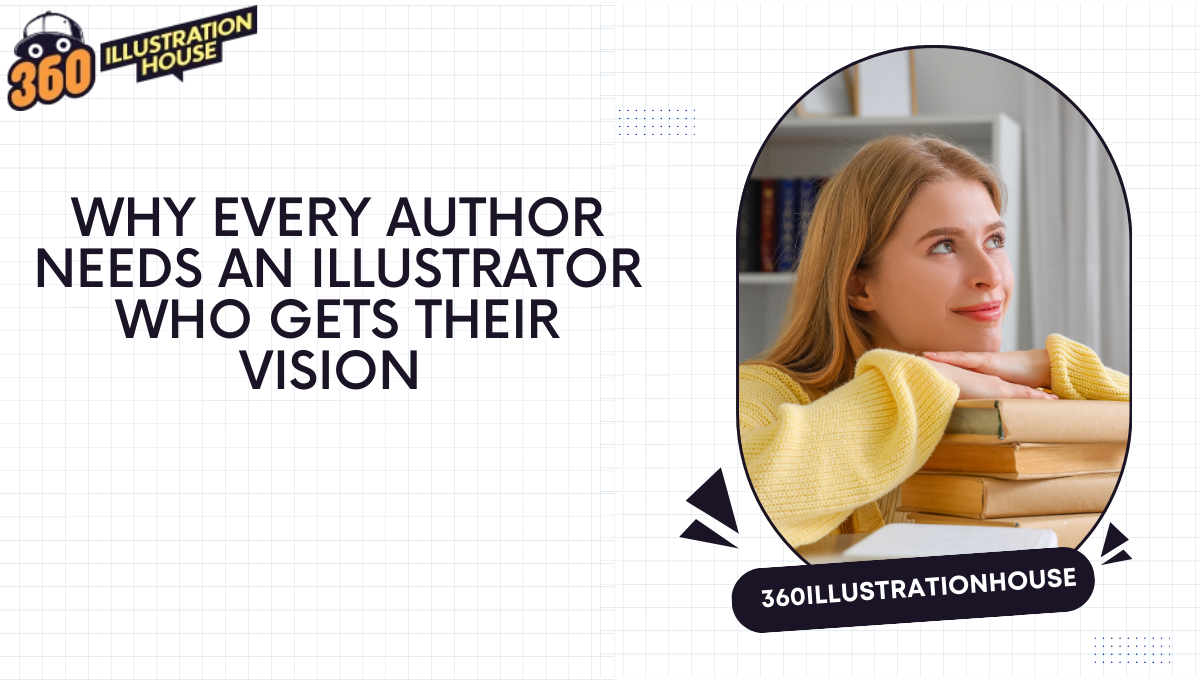Why Every Author Needs an Illustrator Who Gets Their Vision


“The magic of a great story doesn’t end with words—it expands through visuals.”
In fantasy fiction and illustrated stories, the relationship between author and illustrator is more than a collaboration; it’s a creative partnership. The right illustrator brings your characters to life, shapes the tone of your book, and expresses what words alone sometimes can’t.
In traditional publishing, illustrators are often assigned to a manuscript. But when you find a creative partner who truly understands your vision, book illustration becomes a collaborative art form that transforms your story into something unforgettable. Whether you’re self-publishing or working with a publisher, the illustrator you select plays a crucial role in how your book connects with readers.
This guide offers practical advice for authors ready to collaborate with illustrators, so your story doesn’t just get told, it resonates long after the last page.
Key Takeaways
- A skilled illustrator does more than draw. They help tell the story through pictures. Their work adds to the pacing, mood, and feelings of the book.
- When visuals don’t match the tone or message, readers may feel disconnected. Choosing someone who understands your story is essential.
- Author-illustrator alignment leads to a seamless reading experience, making the final copy feel cohesive and impactful.
- Great illustrators understand and show the unspoken emotions, like quiet moments, small hints, and feelings that make the story deeper.
- Legal clarity matters: copyright and usage rights should always be agreed on in writing. This protects both the author’s intent and the illustrator’s work.
- Whether it’s a picture book or a comic, the right visual partner, like a freelancer or an illustration design agency, can turn your manuscript into something amazing.
The Importance of Vision Alignment
1. More Than Just Decoration
Strong book cover artwork or chapter illustrations do more than look appealing. Great visuals set the story tone and pace, adding emotional depth and subtext. In children’s books, especially, the images are part of the narrative.
2. The Risk of Mismatched Visuals
If an illustrator doesn’t understand your tone or characters, they can unintentionally alter the emotional impact of your story. This can confuse readers or make key scenes fall flat, especially when images play a leading role in storytelling.
3. Reader Respond to Visual Cues Before They Read a Single Word
Illustrations influence readers long before the first sentence is read. The style, composition, and mood of an image give immediate signals about the tone and content of your book.
This is especially true for:
- Children’s books (where illustrations are half the story)
- Graphic novels (where visuals carry the narrative)
- Fantasy or sci-fi (where world-building visuals matter)
- Memoirs (where spot illustrations or chapter art can add emotional context)
If an illustrator doesn’t grasp your message, they might pick colors, angles, or images that don’t match your theme. This mismatch can confuse readers, lessen the emotional effect, or attract the wrong audience to your book.
A good illustrator takes your genre, audience expectations, and emotional beats into account and then reflects those through style and symbolism.
4. Your Illustrator Helps Define the Brand of Your Book
Books are not just stories; they are also products. Products need a brand. The font, layout, color scheme, and overall look all help shape your book’s identity.
If your story is serious and slow-burning, but your cover or character design feels cartoonish or overly bright, readers won’t know what to expect.
That mismatch leads to returns, bad reviews, or simply a lack of interest. And surely, no author wants this, right?
An illustrator who gets your vision ensures that your book illustration supports your message instead of contradicting it. They work around these questions:
- What tone are we aiming for?
- Who is the reader, and what speaks to them visually?
- How do we create a consistent look across cover, interior, and promotional materials?
This visual consistency becomes part of your author brand, especially if you’re planning a series or multiple projects. Readers recognize and remember you by both your voice and your visuals.
5. Interpreting the Unspoken
A great illustrator doesn’t simply draw what’s on the page. They sense the mood, capture silences, and translate implied feelings into powerful visuals.
They notice subtle emotional cues that readers might miss and weave them into the art. In book illustration, this ability to say more with less often defines a truly memorable story.
6. Respecting Creative Boundaries
You can align vision only when an illustrator and author respect each other’s creative boundaries. One thing that should not happen is micro-management.
Here, the idea is to develop mutual trust and clear communication. The best collaborations happen when authors clearly articulate their vision, tone, setting, and emotional journey. While giving illustrators creative freedom.
This process is even smoother when working with an experienced illustration design agency. It can help translate your story into a visual style tailored to your audience and genre.
7. Creative Synergy Between Author and Illustrator
When author and illustrator feed off each other’s ideas, the narrative deepens. A single illustration can inspire an author to enhance a scene or refine dialogue. At the same time, well-crafted text can motivate an illustrator to create richer, more immersive visuals. This ongoing exchange creates a dynamic storytelling partnership.
A kind of partnership that is rare, powerful, and unforgettable.
Legal and Practical Factors to Consider When Hiring Experts
Copyright Ownership
In most cases, the illustrator retains copyright to their artwork, while you receive a license to use the images in your book and promotional materials. It’s essential to get this agreement clearly defined in writing to protect both parties and avoid misunderstandings.
Usage Rights
If you plan to promote your book on social media, merchandise, or in advertisements, make sure your contract explicitly allows these uses. Don’t assume you have the right to use something. Make sure to ask about them at the start. Professional illustrators and design agencies can help you figure this out early on.
When Your Visuals Are the Product
If your book is primarily visual, such as a graphic novel or comic, you may need to negotiate shared ownership or extended rights of book illustrations beyond typical licenses.
In these cases, working with a trusted comic illustration service ensures you have the right legal protections and access to specialized creative talent.
Conclusion
Every author should work with an illustrator who truly gets their vision. When the story and visuals work together, the result is unforgettable.
When you’re creating a children’s story, writing fantasy, or working on your first graphic novel, remember to consider visuals from the very beginning instead of treating them as an afterthought. Great book cover artwork and character illustrations bring your words to life.
Whether you work with an independent comic book illustrator or a full-design service provider, choose a partner who sees and understands your vision and works with you in harmony.
FAQs
Usually, no. Traditional publishers often select the illustrator after acquiring the manuscript. If you’re self-publishing or working on a project you really care about, adding illustrations, especially by teaming up early with a comic illustrator or visual storyteller, can make your idea more engaging and appealing.
That’s a red flag. Before committing, always review an illustrator’s portfolio and have a clear discussion about your vision. A good illustrator should understand the mood, pacing, and emotional layers of your story, not just draw nice pictures.
Only if your contract allows it, make sure to explain usage rights from the start, especially if you plan to use images for social media, ads, or products. An experienced illustration design agency can help you navigate these terms.
It’s usually best to finish most of your manuscript before bringing in an illustrator. This helps keep the story clear and consistent. However, talking with the illustrator early on can be helpful, especially for book covers or projects that rely heavily on visuals. It can help make sure everyone has the same creative ideas from the beginning.
Start with trusted directories (like SCBWI or ASA Style File), personal networks, or Instagram. For highly visual stories like comics, working with a specialized comic illustration service can save time and provide genre-appropriate talent.




